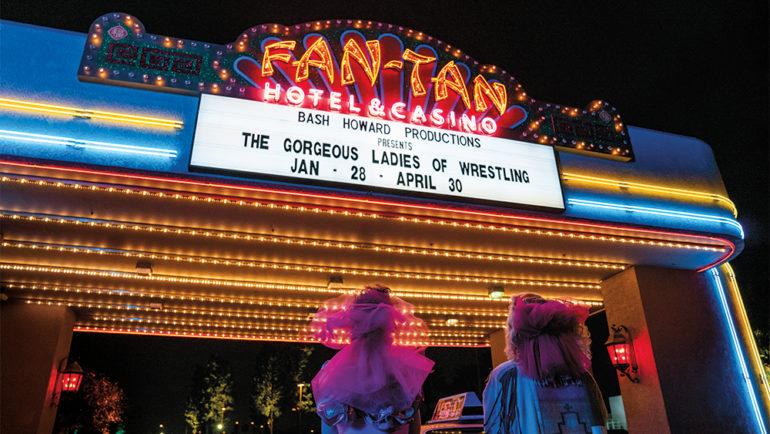‘GLOW’ Team Talks Re-Creating 1980s Las Vegas as a ‘Claustrophobic Place’
By Danielle Turchiano
LOS ANGELES (Variety.com) – Las Vegas is a “city that erases itself and builds itself anew to keep up with the times and the consumerism,” says “” co-creator and co-showrunner Carly Mensch. So when she and co-creator and co-showrunner Liz Flahive decided to set their 1980s women’s wrestling comedy in Sin City for its third season, they knew production would have to rebuild the Vegas of that era rather than finding a way to shoot today’s iteration.
“We wanted Vegas to be this claustrophobic place — especially the hotel, in terms of people living on top of each other, living where they work. They’re all eating together; there’s no air,” Flahive says.
After meticulous research with Vegas historians and the show’s location scouts, the team found a hotel by the airport in Ontario, Calif., that had the right architecture, as well as some key structural elements they wanted to use: a marquee, the lobby, a restaurant and a pool and hot-tub area.
Other integral sets were built on soundstages, including the interiors of hotel rooms, hallways, the penthouse suite, the elevator, the showroom and backstage. All required production designer Todd Fjelsted and his team to bring in specific period-accurate touches for the fictional Fan-Tan Hotel and Casino.
Slot machines and roulette tables were found items, and on one occasion, Fjelsted was able to recycle a Season 2 design. “The backstage area was a completely reconstructed version of Sam’s office at the gym,” he says. “We have so much in storage, so many materials, it was a matter of repainting, reworking and redressing.”
Since so much of the third season is spent with the women of the show-within-the-show getting ready for their nightly performances and making major decisions backstage, Fjelsted says it was important to make sure that space felt “intimate and solid” and allowed “the characters to pop forward” while within it.
Leading with character also proved key when Fjelsted was creating the color palette for the season.
“There’s not a single set we ever saw before, so we didn’t want it to be a complete rebrand and be too jarring,” he says. “The primary way to make that blend work seamlessly was with costuming. Obviously we’re familiar with these characters and certain repeat props, and we didn’t want to impede the colors. It was a matter of finding ways to work with them organically.
For instance, if we wanted to do something in red, instead of going bright red, you go mauve.”
Designed to be a “hodgepodge of generalized Asian influence,” the Fan-Tan mixes design elements from cultures including Japanese, Thai and Chinese, and was created as an off-Strip hotel. This meant Fjelsted wanted the Strip to be visible from certain window views within the sets he was building.
Instead of relying on post-production for a composite, the designer worked with MiniWorld Studios to create a miniature version of the Las Vegas Strip. They “programmed millions of tiny LED lights to act exactly like the bulbs in the neon lights on the Strip in the ’80s,” he says, adding that the lights were operated by a practical computer system on set. “I think the only VFX were to remove cellphone towers in the background of some shots.”

